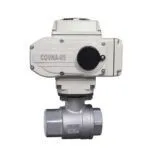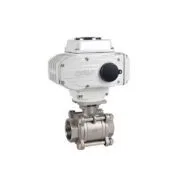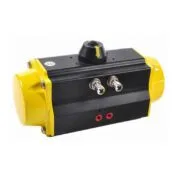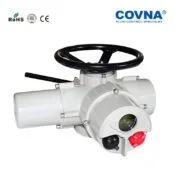

COVNA HK60-Q-2PS DN50 Female Thread Motorized Actuator Ball Valve
Two piece two way GB standard motorized ball valve, electric actuation. 316 stainless steel body, with a quarter turn 90 degree electric actuator. Torque range from 50Nm to 160Nm. Size optional: 1/2 inch, 3/4 inch, 1 inch, 1 1/4 inch, 1 1/2 inch and 2 inch. Available in DC-12V, 24V; AC 110V, 220V, 380V 50/60Hz. Widely used in water treatment, etc.
COVNA is professional electric ball valve manufacturer over 2o years. Offer different type electric ball valve, electric butterfly valve, pneumatic actuated ball valve, pneumatic actuated butterfly valve.
Model: HK60-Q-2PS
Size Range: 1/4” to 4”
Pressure Range: 0 to 1.6MPa
Material: Stainless Steel
Medium Pressure Stainless steel Motorized Valve for Water Features:
The dual–piece, large-diameter sphere valve implements an optimized structural design which provides improved flexibility and convenience of operation. The reliable product quality and significantly reduced defective rate is achieved while avoiding medium erosion is achieved by the sealing surface and the normally closed ball structure. This has also greatly improved the reliability of maintenance of the equipment. The strength and toughness of the valve body material is high which means it can withstand rapid installation and commissioning. Furthermore, the complex working conditions of corrosive media like Water, Gas, Steam, Oil, Nitric Acid, Acetic Acid, etc. are effortless to cope with. Unlike conventional products, this actuator valve optimizes cost through process innovation, increasing the value of fluid control systems for companies. With performance indicators surpassing industry benchmarks, comprehensive costs are reduced, without sacrificing standard performance.
Technical Parameters of Valve Actuator
| ON/OFF Type | Feedback: the active contact signal, passive contact signal, resistance, 4-20mA |
| Regulation Type | Input & Output signal: DC 4-20mA, DC 0-10V, DC 1-5V |
| Field operation | The Field, Remote Control Switch Regulation and MODBUS, PROFIBUS Field Bus |
| Voltage Optional | AC110-240V 380V 50/60HZ: DC12V, DC24V, Special Voltage Can be Customized |
| Protection Class | IP65, Explosion Proof Construction Are Available: EX ll BT4 |
Technical Parameters of Valve Body
| Body | Valve components | ||
| Size Range | DN08-DN100 | Seating material | PTFE: -20℃~180℃ PPL: -20℃~150℃ |
| Body Material | SS304, SS316, SS316L | Core Material | Stainless Steel |
| End Connection | Female Thread | Stem Material | Stainless Steel |
| Operating Pressure | PN1.6MPa | Applicable media | Control of water, Air, Gas, Oil, Liquid, Steam |
| Structure | Floating ball core | ||





